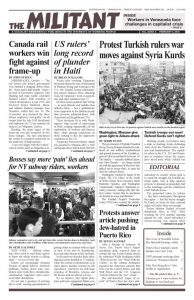Weeks after revoking Temporary Protected Status for tens of thousands of Haitians living and working in the U.S., the Donald Trump administration barred Haitians from obtaining visas for temporary work in agriculture and other industries Jan. 17.
Do these moves indicate that Trump — as most liberals and middle-class radicals claim — has a qualitatively worse approach to the Haitian people than previous administrations, both Democrats and Republicans? No.
These decisions fit in with Washington’s long record of intervening in Haiti, reaping superprofits off the exploitation of workers and farmers there, while placing restrictions on those seeking to flee the oppressive conditions to the U.S.
Temporary Protected Status, which was granted to Haitians after a 2010 earthquake there killed about 300,000 people and left 1.5 million homeless, is being revoked as of Jan. 22. That means some 60,000 Haitians must leave the U.S. within the next 18 months, many of whom have children born here, barring some kind of reprieve in Congress.
While just a few dozen Haitians have applied each year for H-2A and H-2B visas since they were approved for the program in 2012, mostly for seasonal agricultural work, the administration says 40 percent of these visa holders overstayed in 2016.
Decades of imperialist plunder, and naked theft before that, has resulted in some 60 percent of Haiti’s population living under the government’s official poverty line. Many workers get wages of less than $1 a day. The official unemployment rate is 40 percent. More than 70 percent of the population has no access to electricity and over 60 percent have never had the opportunity to learn to read and write. Nearly 75 percent of Haitians are subsistence farmers. Facing extreme poverty, they’ve resorted to cutting down trees to provide fuel. Coming on top of years of farming by foreign companies, this means the country has only 2 percent tree cover, magnifying the impact of hurricanes and floods that destroy crops and wash away homes.
Garments produced under sweatshop conditions in factories in Haiti are exported to Walmart and others for sale in the U.S. Through unequal trade relations — Haiti exports about $1 billion of apparel and agricultural products while spending triple that amount to import food and manufactured goods — the government’s debt has risen to $2 billion, over one-fourth of the country’s gross domestic product.
In the 1990s, Democratic President Bill Clinton pressured the Haitian government of Jean-Bertrand Aristide to lower tariffs on imported agricultural produce. The influx of cheaper U.S. food drove thousands of Haitian peasants off the land, forcing the import of basic staples like rice. Today more than half of Haiti’s food supply is imported.
Colonized first by Spain — which kept control over what became the Dominican Republic on the other side of the island — and then France, Haiti was exploited to produce sugar. After killing off the native population, which didn’t take to slavery, the French brought slaves from Africa.
Inspired by the U.S. and French revolutions of the 18th century, Haitian slaves organized a mass uprising that defeated Napoleon’s troops, abolished slavery and declared independence in 1804.
Washington’s long-standing hatred
Washington’s long-standing hatred of Haiti and its fighting toilers dates back to these revolutionary advances. The pro-slavery rulers here feared the Haitian Revolution would inspire revolts in the U.S. South. They were determined to prevent this.
The former colonial master in Paris refused to recognize the revolutionary regime, insisting the new republic pay huge reparations to France, which began in 1825 and lasted until 1947. To finance this, the Haitian government took out huge loans from U.S., German and French banks at exorbitant rates of interest. By 1900, Haiti was spending about 80 percent of its national budget on loan repayments, reported the Guardian, stifling any prospects for economic and social development.
In response to a wave of popular protests in the early 1900s, U.S. Marines invaded Haiti in 1915 and occupied the country for the next 19 years.
The U.S. government backed the dictatorships of Francois “Papa Doc” Duvalier and his son Jean-Claude “Baby Doc” and their notoriously brutal Tonton Macoute thugs from 1957 until 1986 — under the administrations of Republican Dwight Eisenhower, to Democrats John Kennedy, Lyndon Johnson, Republicans Richard Nixon, Gerald Ford, Democrat Jimmy Carter and Republican Ronald Reagan.
In 1986 workers and farmers rose up and overthrew the U.S.-backed dictatorship. In 1990 Aristide, a Catholic priest and prominent critic of the Duvaliers, was elected president. He was overthrown by the military seven months later and forced into exile.
In response, tens of thousands of Haitians fled the country, seeking refuge in the United States. President Clinton vowed to intercept them at sea and force them back to Haiti. When this didn’t work, U.S. forces incarcerated them at the U.S. Naval Base on occupied Cuban territory at Guantánamo.
20,000 U.S. troops sent to Haiti
Concerned about ongoing protests by workers and farmers in Haiti, Clinton sent 20,000 U.S. troops there and returned Aristide to power in October 1994. Then, in the face of renewed protests, Washington forced Aristide back into exile in 2004.
Some 300,000 people were killed when Haiti was battered by a disastrous earthquake in 2010. Under the watch of Democrat Barack Obama, the U.S. rulers promised lots of aid, but did little. Washington announced it would build 15,000 new homes, but completed only 2,649 before quietly shutting down the program.
The U.N. appointed Bill Clinton its “special envoy” to Haiti and he and Obama’s Secretary of State Hillary Clinton went there to announce the opening of the Caracol Industrial Park, which they said would offer 60,000 jobs for Haitians.
To do so, they drove 450 farmers off their land. Ultimately, only 5,000 jobs materialized — mostly at one big garment plant paying $5 a day, less than half what’s required to eat.
Washington arranged to have its occupying troops replaced by thousands of U.N. forces, who occupied the country until October 2017, tasked with rebuilding Haiti’s police force and army.
This so-called peace-keeping mission was disastrous for Haitian working people. Waste leakage from a camp where U.N. soldiers were based led to an outbreak of cholera that has killed more than 10,000 people and sickened over 800,000.
It was only the rapid response of the revolutionary government of Cuba that made a difference in saving the lives of patients affected by the cholera epidemic. The number of volunteer Cuban doctors and health care workers in Haiti grew to more than 1,200. They set up clinics from the cities to the most remote parts of the country.
The U.N., which promised to provide $400 million to treat those affected by cholera, has collected only about $2.7 million. The Trump administration has said it won’t contribute anything.
As this brief history of the U.S. rulers’ relations with Haiti shows, Trump continues to carry out their bipartisan policies there.

